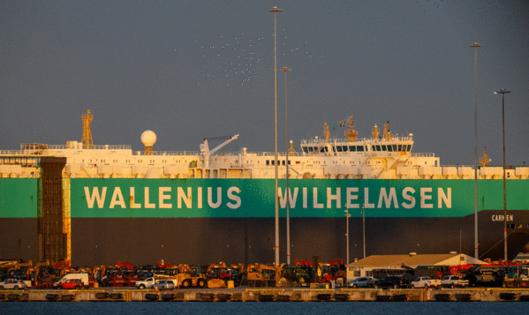Thousands of Baltimore port workers face uncertain future after Baltimore bridge collapse
Published in News & Features
BALTIMORE — Paychecks will soon run out for thousands of workers who handle cargo on Baltimore’s docks, and the region’s port is just starting on what could be a long, uncertain path.
Vessel traffic to and from the Port of Baltimore’s numerous terminals has been blocked since early Tuesday, when the Francis Scott Key Bridge was struck by a freighter and crumbled, killing six people. Two bodies were recovered while four more people are presumed dead.
With a partial port shutdown, little work is left for the longshoremen, counted among the port’s 19,970 cargo workers at both public and private terminals. For now, workers are unloading and delivering cargo from ships that docked north of the bridge before the container ship Dali hit a support pier just before 1:30 a.m. Tuesday. One more vessel, loaded with autos, offered a bit more work when it arrived Wednesday at Tradepoint Atlantic, the Sparrows Point logistics hub outside the blocked waterway. But work at what is typically one of the nation’s busiest ports is about to dry up.
“We have very little work left,” lasting maybe a week, said Scott Cowan, president of the International Longshoreman’s Association Local 333. “We’re going to have quite a bit of people out of a job and not receiving a paycheck very shortly. ... It’s going to be soon.”
The local represents about 2,500 members, and at least 2,000 are expected to be left jobless, Cowan said. But they are part of a much bigger daily workforce of 8,000 people, including terminal, rail and tugboat operators, pilots and truckers, who have been directly affected, Gov. Wes Moore said in a news conference Thursday evening.
In Annapolis, state legislative leaders shared a draft of a bill Friday that might help.
Under the proposal, the Department of Labor would create a temporary financial relief program for people who regularly perform paid work at the port, can’t return to work because of the closure or don’t qualify for unemployment while the Port of Baltimore is closed.
Estimates of how long it will take to clear and reopen the shipping channel range from weeks to months. Crumpled sections of the bridge and the damaged freighter clog the Patapsco River, while recovery efforts continue. On Thursday, federal officials approved an initial $60 million request from the Moore administration to cover preliminary costs for mobilization, operations and debris recovery.
The number of direct and indirect jobs feeling the impact, at least 100,000, represents about 10% of total employment in the Baltimore area, said Jeremy Schwarz, chair of economics at Loyola University of Maryland’s Sellinger School of Business. That may be a conservative number, he said, because estimates of indirect jobs, such as suppliers and truckers, may leave out businesses such as restaurants whose customers are port workers.
“Those workers and their families are certainly going to be hurting without relief,” Schwarz said. “That’s going to be a big strain on those families, of course through no fault of their own.”
Other concerns are whether workers can be absorbed into the workforce and what impact any reduced spending power, even temporarily, could have on demand in the local economy, he said.
“The labor market in Maryland probably has never been stronger, with low unemployment,” he said. “So it is possible that the economy is better situated than other times to absorb some of those workers. The economy’s strength is at least a plus.”
If it takes longer than expected to clear the channel, however, the port risks losing people with specialized skills, and that could make it more difficult to recover, Schwarz said.
In the short term, Cowan hopes more car-carrying vessels will arrive at the single berth at Tradepoint, home to auto terminals for BMW and Volkswagen and miles of warehouses for Amazon, FedEx, McCormick & Co. and others. On Wednesday, the Wolfsburg, a regularly scheduled “roll-on/roll-off” vessel for Volkswagen, arrived at Tradepoint. It was the first cargo to arrive since the bridge collapsed.
But the schedule remains uncertain at Tradepoint, a bustling distribution hub but one with limited capacity for ships and larger “roll on/roll off” vessels and no container terminal — although one is planned. As carriers and shippers have rerouted cargo to other port cities, Cowan worries that some of Tradepoint’s regular arrivals have been and will be diverted too.
Tradepoint officials said this week they have been in increased communication with shipping companies in hopes of taking in redirected cargo.
“Tradepoint Atlantic has an existing (roll-on/roll-off) operation that is well equipped to handle additional levels of cargo,” an official said in an email Thursday. “Plans to accept redirected cargo are underway, including the ability to handle the increased capacity.”
Kerry O’Doyle, Tradepoint’s managing director, said the hub will offer facilities that authorities can use while clearing the channel so as to enable shipping to resume more quickly. The logistics hub resumed operations Wednesday after assisting in search and recovery efforts Tuesday.
“Tradepoint Atlantic is committed to being an active partner during the recovery, clean up, and rebuilding process,” Doyle said in a statement.
Between $100 million to $200 million of goods sails in and out of the port daily, U.S. Secretary of Transportation Pete Buttigieg said at a White House briefing Wednesday afternoon. It handled a record 52.3 million tons of foreign cargo worth $80 billion last year and ranks first among the nation’s ports for the volume of autos and light trucks, heavy farm and construction machinery, imported sugar and imported gypsum.
The port generates $3 billion in personal income annually, Senate President Bill Ferguson, a South Baltimore Democrat, said Wednesday when announcing along with other leaders in the General Assembly plans for emergency legislation to offer economic relief to displaced port workers and small businesses that serve the port.
On Thursday, the Mayor’s Office of Employment Development urged anyone whose job has been affected by the bridge collapse to fill out an online form to be connected with a Career Center for assistance.
Financial assistance can’t come soon enough for Cowan.
“We need to put money in the pockets of people who are not getting a paycheck, so they can pay their bills, feed their families and take care of their daily needs,” Cowan said. “We need action now, and I’m sure it’s going to take a lot longer than now.”
Cowan said he hopes people will remember the role longshoremen played during the pandemic in getting products to consumers, when “a lot of that stuff came through the port of Baltimore.”
“Now the shoe’s on the other foot,” he said. “We worked through the pandemic when many weren’t working, and we were still getting goods to them. Now we aren’t working.”
Roland Rexha, secretary/treasurer of The Marine Engineers’ Beneficial Association, a maritime union with roots in Baltimore and a training school in Easton, said his members will have to make adjustments but won’t be out of work. The union, with several hundred members in the Baltimore area, represents engineers and deck officers on foreign and domestic ships.
“We’ll be able to adapt, but I worry about my brother and my sister union, the longshoremen. They’re going to be the ones hurting,” Rexha said. “If you see somebody who’s down on their luck, this is the time to try to pick each other up.”
He describes the port ecosystem as a “giant heart, and every port a chamber of that heart. If one chamber fails, every other chamber has to push harder to make up for that failure,” he said. “The impact is going to be astronomical,” slowing down the supply chain and making goods less accessible.
Local 333 officials are working to help their members on several fronts, Cowan said. They’re encouraging workers to file for unemployment, seeking relief from the union’s international arm and working to preserve health and other benefits.
It’s too soon, Cowan said, for many workers to know what’s next.
“I think it’s still sinking in, to be honest,” he said. “We’re hopeful that the channel’s going to be open quickly, and they’re going to get back to work.”
_____
©2024 Baltimore Sun. Visit baltimoresun.com. Distributed by Tribune Content Agency, LLC.







Comments